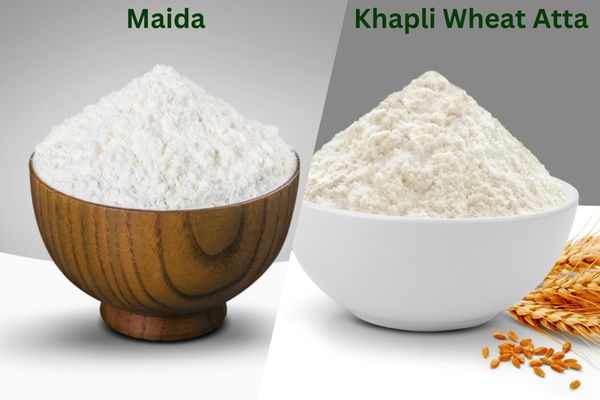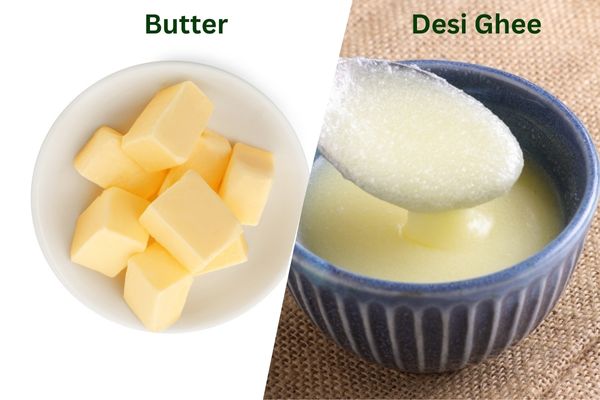Managing diabetes requires careful attention to diet, particularly carbohydrate sources that impact blood sugar levels. Whole grains such as Khapli wheat (Emmer wheat atta) and Ragi (finger millet) are considered diabetic-friendly due to their low glycemic index and rich nutrient profile. But which one is better for diabetics?
In this article, we will compare Khapli wheat vs Ragi in terms of their nutritional composition, glycemic impact, health benefits, and scientific evidence to help diabetics make an informed choice.
Nutritional Profile of Khapli Wheat and Ragi
Understanding the nutritional composition of these grains is crucial for diabetics looking for low glycemic index grains.
|
Nutrient (per 100g) |
Khapli Wheat (Emmer Wheat Atta) |
Ragi (Finger Millet) |
|
Calories |
320 kcal |
336 kcal |
|
Carbohydrates |
65g |
72g |
|
Dietary Fiber |
10g |
11g |
|
Protein |
12g |
7.3g |
|
Fat |
2g |
1.3g |
|
Iron |
3.5mg |
3.9mg |
|
Calcium |
25mg |
344mg |
Both Khapli wheat and Ragi are rich in fiber, which helps in blood sugar regulation, but Ragi has significantly higher calcium content, making it beneficial for bone health.

Glycemic Index: Which is Better for Blood Sugar Control?
The glycemic index (GI) is a crucial factor for diabetics. Foods with a lower GI release glucose slowly, preventing blood sugar spikes.
-
Khapli wheat (Emmer wheat atta) has a GI of 40-45, making it a low-GI grain ideal for diabetics.
-
Ragi (finger millet) has a GI of 55-65, which is moderate but still better than refined grains.
Verdict:
Khapli wheat has a lower glycemic index compared to Ragi, making it a slightly better option for blood sugar management.
Health Benefits of Khapli Wheat
1. Low in Gluten & Easy to Digest
-
Khapli wheat has lower gluten content than modern wheat, making it gentler on digestion.
2. Rich in Fiber & Helps Control Blood Sugar
-
High fiber helps slow glucose absorption, preventing blood sugar spikes.
3. Supports Heart Health
-
Contains complex carbs and essential fatty acids that help maintain cholesterol levels.
4. Packed with Antioxidants
-
Helps reduce oxidative stress, which is a common issue in diabetics.
Health Benefits of Ragi
1. Gluten-Free & Good for Gut Health
-
Ragi is naturally gluten-free, making it great for those with gluten sensitivities.
2. Rich in Calcium & Bone-Strengthening Minerals
-
Contains 344mg of calcium per 100g, beneficial for bone health and preventing osteoporosis.
3. Helps Manage Weight & Cravings
-
Keeps you full longer, reducing unhealthy snacking and calorie intake.
4. Good for Heart Health
-
Contains lignans and polyphenols that help reduce inflammation and support cardiovascular health.
Impact on Blood Sugar Levels
Both Khapli wheat and Ragi have blood sugar-friendly properties, but they differ in their effects:
-
Khapli wheat's fiber and protein help regulate blood sugar without sudden spikes.
-
Ragi, despite its moderate GI, has polyphenols and amino acids that improve insulin sensitivity.
Expert Opinion:
Most diabetes experts recommend Khapli wheat over Ragi due to its lower glycemic impact, but Ragi can still be included in moderation.
Scientific Studies and Expert Opinions
-
A study published in the Journal of Food Science and Technology found that Khapli wheat had a lower impact on blood sugar compared to modern wheat.
-
Research in the International Journal of Food Sciences and Nutrition highlighted Ragi’s role in improving insulin sensitivity.
-
Ayurveda considers Khapli wheat as a sattvic grain, beneficial for digestion and blood sugar stability.
Comparison Table: Khapli Wheat vs. Ragi
|
Factors |
Khapli Wheat (Emmer Wheat Atta) |
Ragi (Finger Millet) |
|
Gluten-Free |
No |
Yes |
|
Glycemic Index |
Low (40-45) |
Moderate (55-65) |
|
Fiber Content |
High |
High |
|
Blood Sugar Impact |
Low |
Moderate |
|
Calcium Content |
Low |
High |
|
Ease of Digestion |
High |
Moderate |
Which One Should Diabetics Choose?
If your main goal is controlling blood sugar, Khapli wheat (Emmer wheat atta) is the better option. However, if you need a gluten-free grain rich in calcium, Ragi is a great alternative. Best Strategy: Incorporate both in a balanced way for maximum health benefits.
FAQs
1. Can diabetics eat Khapli wheat daily?
Yes, Khapli wheat has a low GI and is a healthier alternative to regular wheat for diabetics.
2. Is Ragi safe for people with diabetes?
Yes, but it should be consumed in moderation as it has a higher GI than Khapli wheat.
3. Where can I buy organic Khapli wheat flour online?
You can purchase Khapli wheat online from trusted sources like Two Brothers Organic Foods.
4. Which is better for weight loss, Khapli wheat or Ragi?
Both are good, but Ragi helps control appetite, making it slightly better for weight loss.
5. Is Khapli wheat different from regular wheat?
Yes, Khapli wheat is an ancient grain with lower gluten and a better nutritional profile than modern wheat.
Conclusion
For diabetics looking for the best grains, Khapli wheat is a better choice due to its lower glycemic index and better blood sugar control. However, Ragi is still a nutritious gluten-free option that can be included in moderation.
For high-quality organic Khapli wheat flour online, check out Two Brothers Organic Foods and explore their range of diabetic-friendly flours for a healthier lifestyle!











